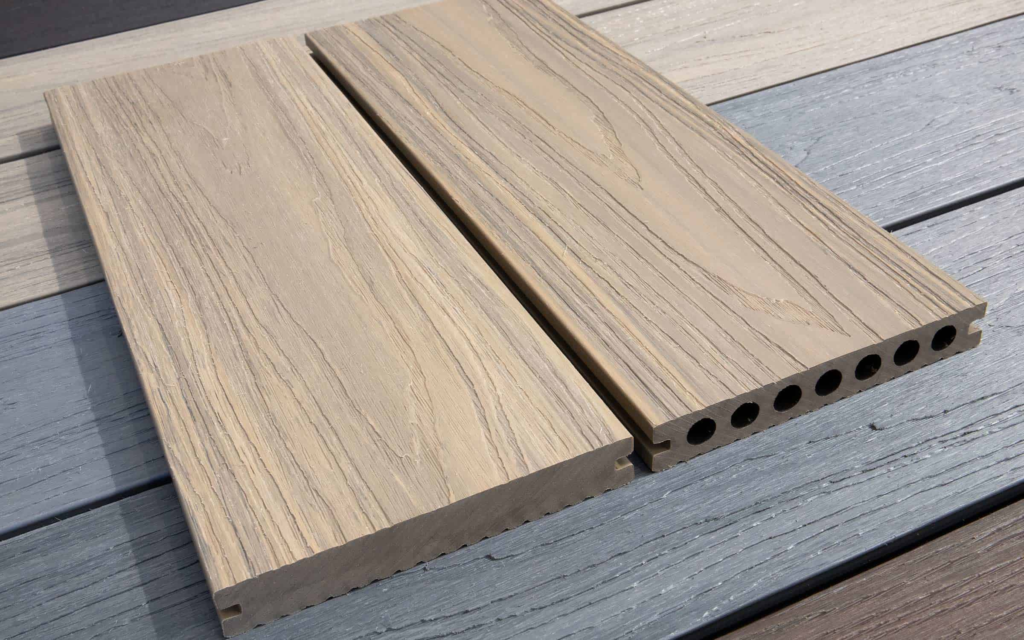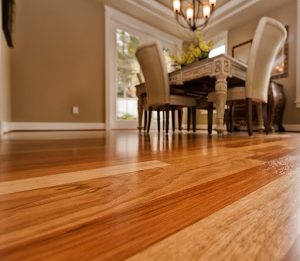Composite Decking
Composite decking is made from artificial deck boards manufactured by mixing recycled plastics, waste wood fiber, and bonding agents. Composite decks require less maintenance and offer more design flexibility than traditional wood decking.
What are solid composite decking boards?
Solid composite decking boards, on the other hand, have less flex, but significantly higher load bearing capacity. They may prove to be the better option if you’re planning to place heavy objects, e.g. a barbecue on your deck. Additionally, these boards may be less susceptible to the harmful effects of weather and corrosion, as their solid centres are much less likely to their hollow counterparts and pure wooden boards to retain water.
What are hollow composite decking boards?
Hollow composite decking boards, which have honeycomb pattern canters, tend to be more flexible and potentially better at absorbing shock. All other things equal, they also tend to be a cheaper option than solid decking boards.
What differentiates these two kinds of composite decking?
THE CORE
The solid boards are usually higher quality than hollow planks. The solid board has a denser structure and weight, which makes it durable and long-lasting. It is heavier because it needs more material during the production process. If you plan to load down your deck with heavy objects or use them in a heavy traffic area, the solid decking boards have greater load-bearing capabilities and offer the most stability.
Hollow composite decking may seem like a great choice at first, but compared with solid composite decking, hollow decking requires less material during the production process, so it is cheaper to produce. Even though it looks durable on the surface, hollow decking can be damaged easily because of its weak internal structure. Over time, it can start to bend, crack, and creek when stepped on. This type of material may be less expensive, however, its low durability means that you may have to spend money on repairing the boards or even replacing them.
2. QUALITY OF RAW MATERIAL
Part of the WPC (Wood Plastic Composite) ingredients is wood fiber. This ingredient contributes to structure capabilities.
Some of the manufacturers replace wood fiber with a cheaper alternative such as rice husk. It saves a significant amount of money on the raw material. Eventually, this leads to weak structure and lower load-bearing.

3. GAPPING
Since the material containing polymer, it makes planks expand and contract under thermal conditions. Due to these features, during the installation, there should be gaps between full-length planks. Without gaps, the boards have nowhere to go when they expand, causing them to warp, buckle and crack.
The manufacturers of the higher quality decking indicate the thermal expansion of 2 to 5 mm which fits in standard gapping measurements. Therefore, materials with higher characteristics require only 2 to 5 mm gap full-length plank.
The lower quality product requires wider gapping, reaching up to 10 – 13 mm between the planks. Large gaps are unattractive, causing tripping hazards and increasing airflow, making your deck more of a fire hazard.
4. COLOUR FADING
Any product exposed to direct sunlight passing through natural weather. How bad the fading will depend on the raw materials used during the manufacturing process. Good quality composite decking boards contain UV ray stabilizers. It helps to control the weathering process and the material won’t change the color under UV effect. However, most woods will lighten over time.
You need to pay attention to low-quality inexpensive imitations claiming that their composite decking boards will not fade or bleach under the sun. Manufacturers avoid mentioning the UV test which is normally ratio not in percentage.
5. WARRANTY
High-quality material can reach up to 50 years warranty for structural performance and color fading and staining.
Whereas, low-quality material can offer a long warranty but with no clear definition. Therefore, it is highly recommended to get the product’s warranty policy to understand the warranty coverage (inclusions/exclusions) is and to determine the recovery rate.



